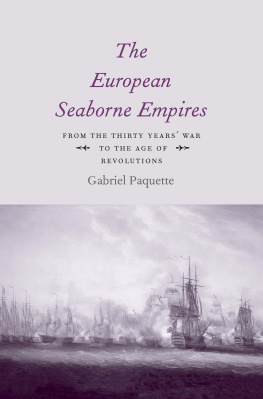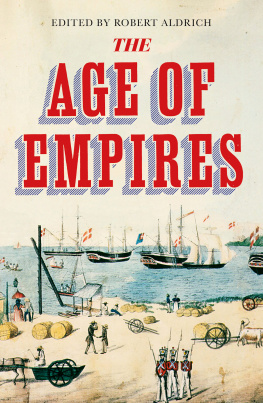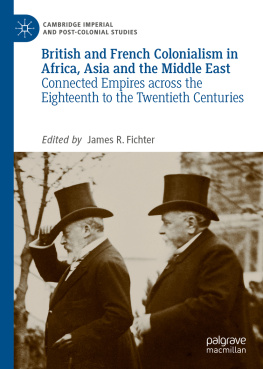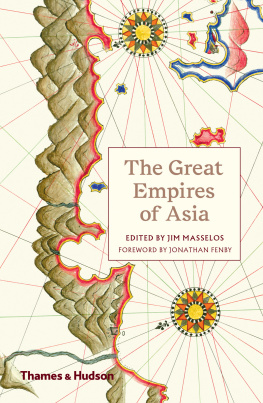The European Seaborne Empires

Published with assistance from the Annie Burr Lewis Fund and from the foundation established in memory of Calvin Chapin of the Class of 1788, Yale College.
Copyright 2019 by Gabriel Paquette.
All rights reserved.
This book may not be reproduced, in whole or in part, including illustrations, in any form (beyond that copying permitted by Sections 107 and 108 of the U.S. Copyright Law and except by reviewers for the public press), without written permission from the publishers.
Yale University Press books may be purchased in quantity for educational, business, or promotional use. For information, please e-mail (U.K. office).
Set in Fournier MT type by IDS Infotech Ltd.
Printed in the United States of America.
Library of Congress Control Number: 2018958332
ISBN 978-0-300-20515-2 (hardcover : alk. paper)
A catalogue record for this book is available from the British Library.
This paper meets the requirements of ANSI/NISO Z39.48-1992 (Permanence of Paper).
10 9 8 7 6 5 4 3 2 1
Contents
Acknowledgments
The reader will share my awareness of this books heavy reliance on the stellar research of hundreds of fellow scholars. I acknowledge their insights in the text itself and, especially, in the endnotes and bibliography. A synthetic and synoptic book, it should be baldly stated, does justice neither to the vast scholarly literature nor to the complexity of the subject itself. I can only hope that the readers interest will have been sufficiently piqued to seek out and read the books and articles I have cited. As this book is designed as an introductory overview of the subject, however, I have sought to record my intellectual debts without cluttering the text with a distracting morass of notes. I have cited English-language works almost exclusively, given that the books target audience is university students in the English-speaking world who may not have access to books in other languages.
I cannot deny or defend this books inequality of proportions and lopsidedness. Some crucial themes are given far fewer pages than they deserve. There is more attention allotted, for example, to the Iberian empires than to either the Dutch or the French. Smaller seaborne empires, such as the Danish, are omitted altogether, chiefly for reasons of space. International relations and political economy receive greater attention than social history. Such emphases and asymmetries reflect my own understanding, knowledge of languages, and knowledge of historiographies, as well as my own tastes, inclinations, strengths, and shortcomings.
I have worked intermittently (and often unconsciously) on this book for more than a decade, in the course of teaching hundreds of undergraduates (and a handful of graduate students) at Wesleyan University, the University of Cambridge, Harvard University, and the Johns Hopkins University. I am profoundly grateful to each and every one of my students for unwittingly sharing some segments of this adventure with me. Several colleagues selflessly expended precious intellectual energy to read the original book proposal and/or draft chapters. I am grateful for their perspicacious insights and suggestions. In particular, I wish to thank Vijay Pinch, Matthew Brown, Manuel Lucena Giraldo, Richard Drayton, and the late Christopher Schmidt-Nowara. I benefited enormously from three readers reports on the original proposal obtained by Yale University Press and from the two detailed reports on the full draft manuscript. I am grateful to my editor, Sarah Miller, for persuading me that this book was worth pursuing. She has been unfailingly patient and solicitous at all stages of the process. Her colleagues at Yale University Press likewise have provided invaluable and timely assistance.
The Department of History of the Johns Hopkins University, my scholarly home between 2011 and 2018, not only provided a congenial work environment but also furnished me with all manner of material support, for which I am profoundly grateful. The staff of the Milton S. Eisenhower Library dealt cheerfully with my innumerable requests. I wrote most of this book in the George Peabody Library. I thank librarians and curators Paul Espinosa and Earle Havens for providing me with a well-lit perch on the fourth floor of that magnificent library. This book was completed at the University of Oregon. I wish to thank the entire UO community for the warmth of the welcome extended to my family.
Several institutions and individuals granted indispensable permissions. Paul Espinosa arranged for the reproduction of several of the images included in this book from the Peabody, and I thank the Johns Hopkins University for granting permission to publish them here. I further thank Neil Safier, director of the John Carter Brown Library, for permission to reproduce images from that librarys unparalleled collection. I am grateful to Bill Nelson for drawing the maps. Furthermore, I have been granted permission to reuse excerpts from the following previously published material: Colonial Societies, in H. M. Scott, ed., The Oxford Handbook of Early Modern European History, 13501750, vol. II (Oxford: Oxford University Press, 2015), 280306; and The Reform of the Spanish Empire in the Age of Enlightenment, in Jess Astigarraga, ed., The Spanish Enlightenment Revisited, Oxford University Studies in the Enlightenment (Oxford: Voltaire Foundation, 2015), 149167.
My wife, Johanna Richlin, deserves more than the passing acknowledgment that I can offer here. Suffice it to say that whatever good is found in this book owes much to her love of and unstinting belief in its author. I dedicate this book to our daughter, Antonia, whose insatiable curiosity has done much to rekindle my own.
Introduction
To study the history of Europes overseas empires is to enter into numerous and long-standing scholarly debates. A major source of these debates is a still prevalent set of assumptions about Europe and the non-European world. Though its influence has waned, historians have depicted Europe as in some way special or unique. Blessed with an array of endowmentscultural, intellectual, racial, materialthat the non-European world purportedly lacked, Europe was portrayed as superior to the worlds other regions. From this starting point, it is but a short leap to conceive of Europes subjugation of the rest of the worldthe formation and maintenance of empireas something natural, inexorable, and good. This is a world divided between leader and follower nations, innovators and imitators, active agents and passive recipients.
These assumptions, and conclusions, have been assailed as the colonizers model of the world. Whatever breakthrough Europe experienced may be attributed chiefly to factors extrinsic to it, to the benefits derived from empire.
There is nothing especially controversial in this statement. It has been recognized by commentators as diverse as Adam Smith and Karl Marx. The Advantages which Europe, considered as one great country, has derived from the discovery and colonization of America, consist, Smith wrote in The Wealth of Nations (1776), first, in the increase of its enjoyments; and, secondly, in the augmentation of its industry. Marx took a dimmer view of the proceedings. He highlighted forced migration, slavery, and the extraction of precious metals, instead of wealth derived from trade, as the indispensable factor in Europes economic efflorescence. As he narrated in Capital (1867), The discovery of gold and silver in America, the extirpation, enslavement and entombment of the aboriginal population... the turning of Africa into a warren for the commercial hunting of black-skins... these idyllic proceedings are the chief moments of the so-called primitive accumulation.... The treasures captured outside of Europe by undisguised looting, enslavement, and murder, floated back to the mother country and were there turned into capital. For Marx, then, overseas empire underpinned nascent capitalist institutions in Europe itself and accelerated their development. A contemporary historian operating in a non-Marxist paradigm, Kenneth Pomeranz, has disagreed with the assertion that Europes development can be attributed chiefly to its access to colonial resources, but he concedes that the fruits of overseas coercion may account for the differences in the growth trajectories of European and Eurasian states after 1800.
Next page









